From Baltimore to Barbary: the 1631 sack of Baltimore
Published in Early Modern History (1500–1700), Features, Issue 4 (Jul/Aug 2006), Volume 14
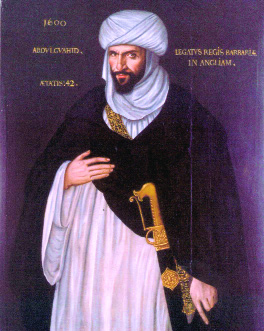
Abd el-Ouahed ben Messaoud ben Mohammed Anoun, Moorish ambassador to Queen Elizabeth I, 1600. The political will on the part of the authorities to redeem slaves was compromised by such diplomatic ties. From 1628, King Charles I was deep in negotiations with commissioners from Salé, Morocco, which resulted in a mutual trade pact. (University of Birmingham)
The sack of Baltimore, the only recorded instance of a slaving raid by corsairs in Ireland, was part of a wider pattern across Europe, encompassing not only the entire Mediterranean region but also the Atlantic seaboard as far north as Iceland. Slave-raiding of Christians by Muslim corsairs became common from the late fifteenth century onwards, coinciding with the expulsion of the Moors from Spain. In his comprehensive study Christian slaves, Muslim masters, Robert Davis sees a direct correlation between the two. He proposes that by expelling the Moors from Spain in the final years of the fifteenth century Ferdinand and Isabella created an implacable enemy, as well as fostering a new dynamism among Islamic North African communities, which manifested itself as a passionate and conscious desire to settle accounts with Christendom.
Slave-raiding as an economic and ideological weapon was not confined to the Muslims of the Ottoman empire and North Africa. European seafaring powers engaged equally in the taking of Islamic ships and the use of their crews as slave labour.
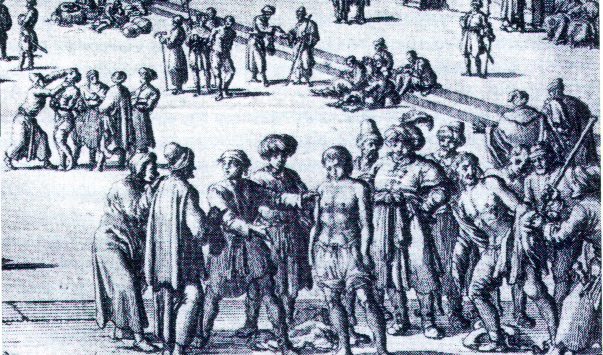
Engraving of a Moorish slave auction from Pierre Dan’s Historie van Barbaryan en des zelfs Zee-Roovers (Amsterdam, 1684). There they were paraded, chained and nearly naked, while prospective buyers inspected the merchandise.
In addition, the European trade in African slaves was also beginning to increase in volume and efficiency. Indeed, the Atlantic slave trade peaked as the Barbary trade went into decline in the eighteenth century. Nonetheless, the Barbary slave trade in the sixteenth and seventeenth centuries for a time outstripped European transatlantic slave-trafficking.
In the sixteenth and seventeenth centuries the Ottoman empire appeared to be in the ascendant, while the Spanish empire, crippled by state debt, was struggling with continual warfare on a variety of fronts. In England domestic tensions between king and parliament were coming to a head. France had been riven asunder by the wars of religion, and the Netherlands was locked into a costly war of independence with Spain.
Typical corsair raid
The sack of Baltimore, with its mixture of opportunism, careful planning and clockwork execution, was typical of the techniques employed in corsair land raids. On 17 June 1631, two vessels sailing out of Algiers—a 300-ton Dutch-built man-of-war, armed with 24 pieces of ordnance and crewed by 200 men, and another vessel of approximately half the size and ordnance—captured a ship from Dartmouth ‘betwixt England and Ireland’. Corsairs used a variety of duplicitous methods to effect the smooth capture of a target ship, including running up the flags of friendly nations, wearing European clothing and hailing crews in their native languages. Aboard their prize was Edward Fawlett and a crew of nine. Having stripped the ship of any useful goods, the attackers scuttled it.
By 19 June the raiders were off the Old Head of Kinsale, where they captured two fishing-boats from Dungarvan, one captained by John Hackett, the other by Thomas Carew, both containing five-man crews. The two twelve-ton boats, now manned by corsairs, joined the little flotilla, which continued westward. Aboard the lead vessel Captain Morat Rais, a Dutch convert to Islam with extensive experience in the North Sea, demanded that Hackett pilot them into Kinsale. Perhaps aware of the presence of the Fifth Lion’s Whelp, under the command of Captain Hooke of the Royal Navy, in the harbour, Hackett allegedly persuaded Rais to continue on to Baltimore.
Baltimore was a familiar harbour to many seamen and had a chequered and controversial history. In 1605 Thomas Crooke purchased a 21-year lease on the town from Sir Fineen O’Driscoll, and set about enticing English settlers to the area. According to a 1608 report from a Spanish ship, most of the native Irish elected not to remain. Crooke is believed to have chosen Baltimore with the specific intention of using it as a supply point for pirates, a charge he was called to answer before the privy council in 1608. Although he was eventually acquitted, the verdict may have been influenced more by a political desire to see an English presence in West Cork than by any genuine belief in Crooke’s innocence. When one considers a contemporary Venetian assertion that Baltimore was one of the two chief nests of English pirates, the charges of piracy against the town gain a measure of credence. By 1631 Baltimore was a small English enclave surrounded by the hostile O’Driscolls. The town relied on the sea and was struggling financially following the death of the energetic and charismatic Crooke.
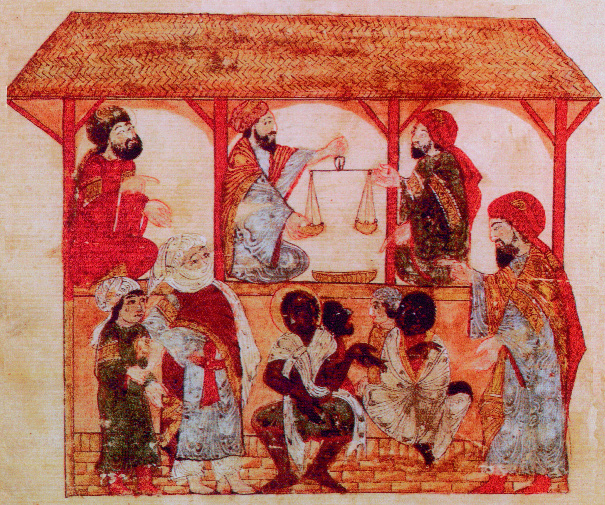
A slave market in Zabid, Yemen, 1237. The actual sale price achieved depended on the abilities of the individual, plus an estimation of how high a ransom could be demanded for them. (Topkapi Saray Museum)
The raiding party was first sighted off Castlehaven. Owing to the Dutch construction of the ships, as well as the possibility that the flags hoisted were those of a friendly nation, observers did not recognise the imminent danger. About 10 o’clock on the night of 19 June the ships anchored east of the mouth of Baltimore harbour. A small boat containing Morat Rais, Edward Fawlett and ten crewmen rowed the not inconsiderable distance to the Cove, a small shingle beach approximately 2km from the main settlement. Fawlett, acting as guide, demonstrated great familiarity with the town and coastline, guiding them to shore and providing a comprehensive outline of the layout and the whereabouts of any men likely to provide resistance. Having familiarised themselves with the town, the reconnaissance party returned to their ships to plan the attack.
Element of surprise
At 2am on the morning of 20 June some 230 men, armed with muskets, landed at the Cove. Quickly and silently spreading out, they divided up and waited at the doors of the 26 cottages along the shoreline. At a given signal, brandishing iron bars to break the doors and firebrands to torch the buildings, they launched a simultaneous attack on the sleeping inhabitants. The terror of the population can only be imagined as they were wrested from their beds by strange men speaking an unknown language. Ironically, Joseph Whitehead, an earlier captive, described his captors’ style of dress as one that did ‘much resemble that of the ancient Irish’.
In the initial foray 100 people were seized. Thomas Corlew and John Davis were killed in the fray. Morat Rais then deployed 60 armed men in an ambush formation along the track leading to the town; taking between 120 and 140 men with him, he continued along to the main settlement, intending to mount another surprise raid.
John Hackett, singled out in subsequent correspondence as an ‘Irish Papist’, accompanied Rais on the raid. Hackett’s motivation was not explored in his testimony and must remain a matter of speculation. Repeating their tactic of a simultaneous surprise attack, the marauders entered 40 houses, rifled 37 of them and captured more victims before the alarm was raised by William Harris, who awakened his neighbours by firing a musket. As another of the inhabitants began to sound a drum to rouse the population, Rais realised that the element of surprise had been lost and retreated back along the track to the cover of the ambush site, and thence to the Cove. The corsairs lost no time in returning to their anchored ships with their booty of twenty men, 33 women and 54 children and youths, to add to the crews of the Dartmouth ship and the Dungarvan fishing-boats. Captain Hooke later claimed that an additional ‘30 men at least from Kinsale’ were taken, but no mention of these captives appears in subsequent documents. Indeed, if men were taken from Kinsale, Hooke’s delay in responding, given this forewarning of pirate activity, seems very irresponsible.
Women and children treated with relative kindness
From the narratives of ransomed captives it is possible to piece together the probable events that took place aboard ship. Many recounted an initial period of harsh treatment for the men in order to ‘break them’. For the first hour or so any male captive who did not keep out of his captors’ way was severely beaten, and in some instances actually hacked to death in a bloody frenzy. Owing to their high retail value, women and children were treated with relative kindness; curtains were erected to allow privacy, facilities for washing were offered, and they were allowed complete freedom of movement below decks. Icelandic narratives recounting a 1627 raid led by Morat Rais emphasise the kindness shown towards children by his crew.
Prior to sailing, five captives were returned to shore—two elderly people from Baltimore along with Hackett, Carew and Fawlett. Hackett was later tried and condemned to death at a sitting of Cork assizes; there appear to be no records of Fawlett and Carew’s fate. Between 3pm and 4pm, the two ships hoisted anchor and, with a total of 154 captives, began the long voyage back to Algiers and the slave auction. On 10 August James Frizell, the English consul, reported the arrival of 89 women and children and twenty men from Baltimore, two more than were claimed in the State Papers to have been taken.
Inhabitants of the town who had managed to escape in the confusion had immediately raised the alarm. On 21 June Sir William Hull wrote to the earl of Cork, expressing his concern at two good pilots having been taken from Baltimore and his willingness to send ‘two sakers and shot to Baltimore and Crookhaven, but there is a complete lack of powder’. Frantic efforts were made by local people to effect a rescue.
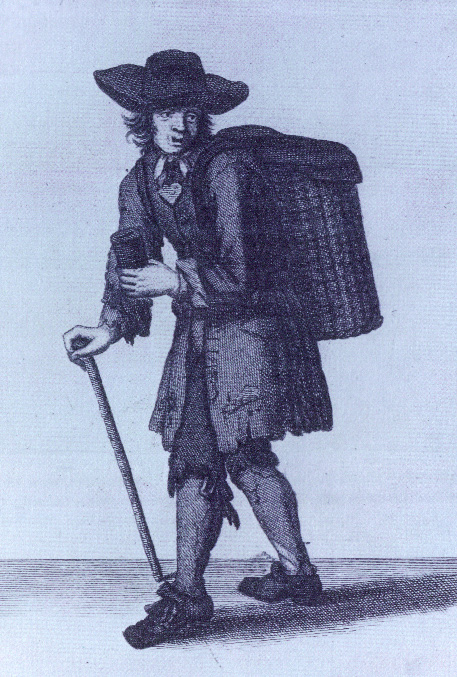
‘Remember the Poor Prisoners’-an Englishman collecting alms for the redemption of slaves, from Marcellus Laroon’s The cryes of the City of London (London, 1688). (Folger Shakespere Institute)
James Salmon of Castlehaven unsuccessfully tried to persuade a Mr Pawlett, who had a ship lying at anchor, to pursue the raiders. He also wrote to Captain Hooke, urging him to set sail with all speed. Hooke replied that he was unable to comply owing to a lack of provisions and ten months’ arrears of pay. He bluntly stated: ‘We cannot go to meet the Turks . . . until we are victualled’. It was several days before Hooke arrived on the scene, by which time the ships were long gone.
Hooke later reported a rumour that the Algerians had been captured off the coast of Spain. A vitriolic correspondence of blame and counter-blame soon erupted. The earl of Cork demanded that Captain Hooke be removed from his position, while Hooke sought to transfer blame to a Bandon supplier whom he claimed was negligent and corrupt, resulting in a lack of provisions.
Sold into slavery
The Baltimore captives were helpless victims awaiting their fate. In Algiers, Frizell reported that all had arrived alive and requested funds to pay for their release. These funds were not forthcoming, owing to the English government’s newly adopted policy of not paying ransoms, as it was believed that to do so would encourage the taking of hostages and act as a disincentive to sailors to defend their ships.
Detainees were immediately taken to the basha, an official who had a right to ten per cent of all booty, including slaves. The rest of the captives, with men and women segregated, would have been sent to slave pens. There they were paraded, chained and nearly naked, while prospective buyers inspected the merchandise. Those not sold in the initial auction were housed in storage facilities or bagnios—large, unsanitary blocks that supplied casual, and expendable, labour on a contract basis. Children had usually been removed from their families by this point and a process of acculturation had begun. There were exceptions, however. Among the 232 captives ransomed by Edmond Cason in 1646 were three children, all male, who were redeemed along with their mothers. Of the total number repatriated by Cason the majority were men, with only eighteen women, whose average price far exceeded that of the men: Elizabeth Alwin of London cost 356 and a quarter dollars, while Mary Bruster of Youghal fetched 300 dollars, the average price for a man being 150 dollars. The ransom prices were determined by the original cost price, though Cason did suspect that the figures had been inflated.
The actual sale price achieved depended on the abilities of the individual, plus an estimation of how high a ransom could be demanded for them. Hands were inspected to see whether they were calloused, and captives were tortured to reveal the identity of any wealthy individuals. Those who had skills such as carpentry or military experience were highly valued, while others were condemned to a short brutal life as a galley slave or labourer on one of the basha’s many building projects. White women were highly valued, and most would have been bought as items of prestige, destined to spend their lives as concubines; for many of them this would have been a life of comparative luxury, any drudgery being assigned to black slaves. There are few references to women being raped, although there is a report of a young woman being despoiled while still ashore during the Icelandic raid of 1627. Whether the lack of records is due to such attacks being considered unremarkable and thus going unrecorded or because they did not occur is a matter for conjecture.
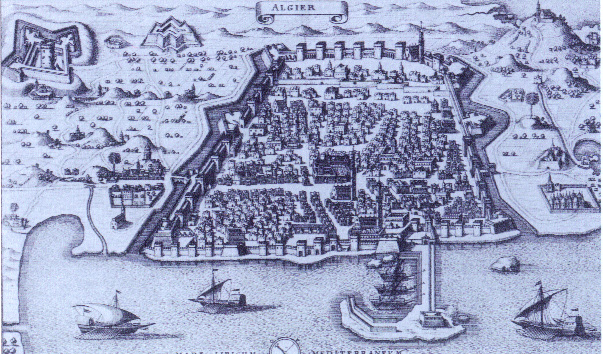
A view of Algiers from Pierre de Montmartin’s Neuwe Archonologia Cosmica (Frankfurt, 1646). (Library of Congress)
The children, usually raised as Muslims and by all accounts treated with the utmost gentleness, would eventually form the bulk of a highly efficient slave corps within the Ottoman army; others were purchased and raised in the homes of local people, seemingly becoming members of the family. Young men, aged from thirteen to seventeen, were subject to considerable cruelty at first, often being castrated and/or forced to convert to Islam before being dispatched to the furthest points of the empire.
Of all the Baltimore captives there are few of whom it can be stated with any certainty that they were eventually ransomed. Edmund Cason reported paying the sum of 150 dollars for the release of Joan Broadbroke, either the wife or daughter of Stephen Broadbroke, and a paltry 86 dollars for Ellen Hawkins. Ellen’s name does not appear on the original list of captives. There are, however, five unnamed women simply listed as ‘maid’, and it is probable that Ellen was one of these. The two women, having spent fifteen years in captivity, returned safely to England. Their eventual fate is as yet unknown, as is the fate of the other 105 people, and merits further investigation.
The political will on the part of the authorities to seek out and protect captives was questionable when one considers that from 1628 King Charles I was deep in negotiations with commissioners from Salé in Morocco, the other main port of white slavery, that resulted in a mutual trade pact being signed with Mulay al-Walid, emissary of the sultan, between November 1631 and February 1632. In 1633 Frizell reported that only 70 captives were available for redemption, ‘the rest being dead or turned Turk’. He did report the ransoming of an unnamed woman by ‘a Mr Job’, but gave no further details. In addition to the two Baltimore captives, Cason secured the emancipation of ten of the 120 captives taken from the packet ship John Filmer off Youghal in 1641.
Epilogue
By the late eighteenth century the balance had shifted, and the North Atlantic sea powers, in particular England, owing to growing naval pre-eminence, were beginning to occupy the dominant position. The widely held belief that the Ottoman empire was in decline gave impetus to European colonial attempts to form outposts in North Africa and to challenge the Ottomans militarily. The expanding power of the Royal Navy allowed it to successfully combat Islamic slave-raiding, an activity which, ironically, had been kept viable by a British policy of exchanging arms for captives.
Initially, Baltimore seems to have recovered. By 1632 small units of cavalry were stationed along the coast, beacons were erected on strategic headlands and the town was beginning to rebuild. That same year, however, there were rumours of a planned return by corsairs. In December 1631, Benjamin Whitcomb wrote to his brother from Marseilles, warning of another planned attack by ‘Turks’. For many of the inhabitants of Baltimore the fear was too great, and the majority of those who elected to stay in West Cork moved further inland to Skibbereen. In 1790 one visitor to the town described it as being nothing but a decaying fishing village and rotten borough.
For the captives life was never the same again. Those who were ransomed usually ended their lives in destitution, viewed with suspicion and unable to resettle. A small minority profited from their experiences through the sale of lurid captivity narratives. The majority of those who ‘turned Turk’ blended seamlessly into the fabric of life in North Africa, sometimes rising to positions of influence and prestige that would have been impossible in class-conscious Europe, while others died of culture shock. Of those who remained Christian, most quickly succumbed to overwork and hard usage, their identities and fate unknown. Whatever their fate, all the captives had one thing in common: their lowly status as pawns in a global power game that had been played between Islam and Christianity since the eighth century.
Theresa D. Murray is a PhD history student at University College Cork.
Further reading:
H. Barnaby, ‘The sack of Baltimore’, Journal of the Cork Historical and Archaeological Society 74 (220) (July–December 1969).
E. Cason, A relation of the whole proceedings concerning the redemption of the captives in Argier and Tunis (London, 1647). [Available on Early English Books On-Line.]
R.C. Davis, Christian slaves, Muslim masters (Basingstoke, 2003).
N. Matar, Turks, Moors and Englishmen in the Age of Discovery (New York, 1999).
















